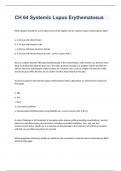-
1. Exam (elaborations) - Viral skin infections exam questions correctly answered 2024.
-
2. Exam (elaborations) - Varicella (you call the shots)review practice test 2024.
-
3. Exam (elaborations) - Types of skin rashes (ch. 17 w pictures) final exam 2024.
-
4. Exam (elaborations) - Systemic lupus erythematosus questions and answers 2024.
-
5. Exam (elaborations) - Sle review study questions 2024.
-
6. Exam (elaborations) - Sle nclex written exam 2024.
-
7. Exam (elaborations) - Skin theory 2 prediction exam questions 2024.
-
8. Exam (elaborations) - Skin rashes study guide test 2024.
-
9. Exam (elaborations) - Skin rashes review practice exam 2024.
-
10. Exam (elaborations) - Rubeola (measles) study practice questions 2024.
-
11. Exam (elaborations) - Rosh dermatology 2 review practice questions 2024.
-
12. Exam (elaborations) - Roseola written exam 2024.
-
13. Exam (elaborations) - Rashes1 questions correctly answered 2024.
-
14. Exam (elaborations) - Rashes practice exam questions rated a+ 2024.
-
15. Exam (elaborations) - Rash correctly answered exam questions 2024.
-
16. Exam (elaborations) - Rash, resp, enteric viruses practice review study questions 2024.
-
17. Exam (elaborations) - Quiz 14 correctly answered 2024.
-
18. Exam (elaborations) - Quiz 2 - skin problems verified advanced questions & answers 2024.
-
19. Exam (elaborations) - Pharmacology chapter 12 advanced questions with verified answers 2024.
-
20. Exam (elaborations) - Pharmacology- ch. 12 - skin medications final exam prediction questions 2024.
-
21. Exam (elaborations) - Peds prepu chapter 15 practice exam test 2024.
-
22. Exam (elaborations) - Ped's i quiz i & ii final exam prediction questions 2024.
-
23. Exam (elaborations) - Peds ch 31 review practice questions 2024.
-
24. Exam (elaborations) - Pediatric rashes review study guide questions 2024.
-
25. Exam (elaborations) - Pathophysiology chapters 1 - 3 exam questions correctly answered 2024.
-
26. Exam (elaborations) - Nr 511 ch7 skin problems study guide exam 2024.
-
27. Exam (elaborations) - Nclex- pediatrics infectious & communicable diseases written exam 2024.
-
28. Exam (elaborations) - Mt ch 12 final exam questions correctly solved 2024.
-
29. Exam (elaborations) - Module 7 skin medications post-assessment exam questions with correct answers 2024.
-
30. Exam (elaborations) - Module 3 dermatology practice exam questions & answers 2024.
-
31. Exam (elaborations) - Microbiology fundamentals ch 16 final exam questions 2024.
-
32. Exam (elaborations) - Microbiology ch.25 rna viruses advanced exam questions & answers 2024.
-
33. Exam (elaborations) - Microbiology ch.23 questions correctly answered 2024.
-
34. Exam (elaborations) - Microbiology ch 22 skin infections prediction exam questions 2024.
-
35. Exam (elaborations) - Micro ch. 16 review practice exam questions 2024.
-
36. Exam (elaborations) - Micro ch 5 practice exam test questions 2024.
-
37. Exam (elaborations) - Lyme disease exam questions and answers 2024.
-
38. Exam (elaborations) - Lupus review practice questions 2024.
-
39. Exam (elaborations) - Integrumentary study guide exam 2024.
-
40. Exam (elaborations) - Infectious causes of skin rashes lesions written exam questions with correct answers ...
-
41. Exam (elaborations) - Identify that rash practice study questions 2024.
-
42. Exam (elaborations) - Icd-10 chapter 12 questions diseases of skin final exam 2024.
-
43. Exam (elaborations) - Homework chapter 3, part 2 review study guide 2024.
-
44. Exam (elaborations) - Ha chapter 14 skin, hair, nails final exam questions 2024.
-
45. Exam (elaborations) - Fever and rash review study guide test 2024.
-
46. Exam (elaborations) - Exam 1 fa davis questions with 100% correct answers 2024.
-
47. Exam (elaborations) - Eaq chapter 13 study guide exam questions 2024.
-
48. Exam (elaborations) - Diaper rash review exam questions rated a+ 2024.
-
49. Exam (elaborations) - Diaper dermatitis study guide test 2024.
-
50. Exam (elaborations) - Conditions of skin- rashes correctly answered questions 2024.
-
51. Exam (elaborations) - Communicable diseases quiz with correct verified answers 2024.
-
52. Exam (elaborations) - Chapter 26 infectious disease hw review exam questions & answers 2024.
-
53. Exam (elaborations) - Chapter 26 infections diseases exam questions correctly answered 2024.
-
54. Exam (elaborations) - Chapter 24 advanced exam questions 2024.
-
55. Exam (elaborations) - Chapter 22 - skin infections study guide test questions 2024.
-
56. Exam (elaborations) - Chapter 21 dermatologic disorders practice exam questions 2024.
-
57. Exam (elaborations) - Chapter 18 nursing management of the newborn final exam questions 2024.
-
58. Exam (elaborations) - Chapter 18 integumentary system diseases and disorders review exam questions 2024.
-
59. Exam (elaborations) - Chapter 17 build your foundation questions with correct answers 2024.
-
60. Exam (elaborations) - Chapter 16 the infant study guide exam questions 2024.
-
61. Exam (elaborations) - Chapter 9 skin, hair and nails final exam questions 2024.
-
62. Exam (elaborations) - Chapter 6 practice exam questions 2024.
-
63. Exam (elaborations) - Chapter 6 quiz b med terms final exam study questions 2024.
-
64. Exam (elaborations) - Chapter 5 icd-10-cm chapters 12-21 final exam prediction questions 2024.
-
65. Exam (elaborations) - Chapter 3 part 2 practical prep exam questions 2024.
-
66. Exam (elaborations) - Chapter 2 quiz correctly answered 2024.
-
67. Exam (elaborations) - Ch 64 systemic lupus erythematosus final exam prediction questions 2024.
-
68. Exam (elaborations) - Ch 3 reading study exam questions 2024.
-
69. Exam (elaborations) - 1101medtermch3integumentary quiz correctly answered 2024 updated.
-
70. Exam (elaborations) - 23 - viral causes of skin lesions rashes review practice questions 2024.
-
Show more




